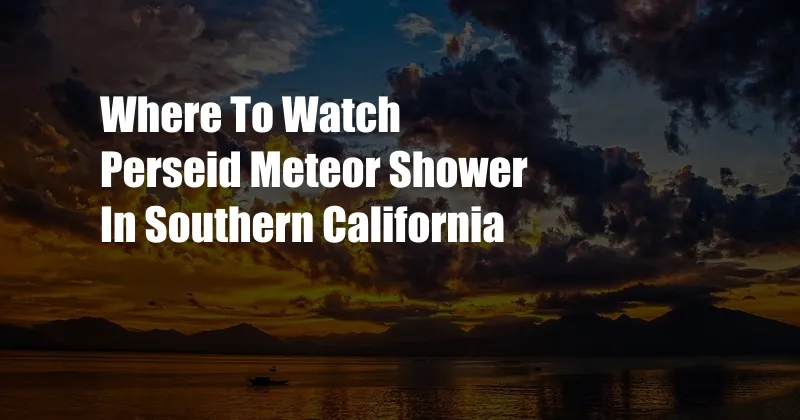
Where to Watch the Perseid Meteor Shower in Southern California
Nestled in the captivating embrace of Southern California, beneath a celestial curtain adorned with shimmering celestial bodies, lies a captivating spectacle that will leave you starstruck. The annual Perseid meteor shower, a breathtaking display of cosmic fireworks, graces our skies from mid-July to late August, peaking in mid-August. During this celestial extravaganza, up to 60 meteors streak across the night sky every hour, painting ethereal trails of light that dance and twinkle with celestial allure.
As the days of summer begin their gentle descent, eager stargazers and cosmic enthusiasts alike turn their gaze toward the heavens, seeking the perfect vantage point to witness this breathtaking celestial display. Southern California, with its stunning natural landscapes and pristine skies, offers a myriad of prime locations for those seeking to immerse themselves in the celestial magic of the Perseid meteor shower.
Dark Sky Destinations in Southern California
To fully appreciate the mesmerizing spectacle of the Perseid meteor shower, it is essential to seek out dark sky destinations where the absence of light pollution allows the night sky to unveil its celestial treasures in all their unadulterated glory. Southern California boasts several renowned dark sky locations that provide an ideal setting for meteor watching:
- Anza-Borrego Desert State Park: This sprawling desert expanse, designated as an International Dark Sky Park, offers vast, open spaces and minimal light interference, providing a breathtaking backdrop for meteor observation.
- Joshua Tree National Park: Nestled within the heart of the Mojave Desert, Joshua Tree National Park is another renowned dark sky destination. Its rugged landscapes, dotted with whimsical Joshua trees, create an otherworldly setting for stargazing.
- Death Valley National Park: Known for its extreme temperatures and desolate beauty, Death Valley National Park boasts some of the darkest skies in the United States, making it an exceptional spot for stargazing and meteor watching.
In addition to these designated dark sky parks, several other locations in Southern California offer favorable conditions for meteor observation, such as remote mountain areas, secluded beaches, and high-altitude viewpoints.
While dark sky destinations provide an optimal environment for stargazing, it is important to note that even in these areas, some light pollution may be present. It is recommended to arrive at your chosen viewing location well before sunset to allow your eyes ample time to adjust to the darkness, enhancing your ability to spot meteors.
Tips for Maximizing Your Meteor Watching Experience
To fully immerse yourself in the enchanting display of the Perseid meteor shower, consider these expert tips and advice:
- Choose an Open Viewing Area: Find a location with an unobstructed view of the sky. Open fields, beaches, and mountaintops provide excellent vantage points.
- Bring a Reclining Chair or Blanket: Comfort is key for extended periods of stargazing. Plan to lie back and relax while enjoying the celestial show.
- Red-Light Flashlight: Regular flashlights can impair your night vision. Use a dim red-light flashlight to preserve your ability to see faint meteors.
- Avoid Looking Directly at the Moon: Moonlight can interfere with meteor observation. If the moon is present, face away from it to enhance your meteor-spotting success.
- Be Patient: Meteor showers are often sporadic. Patience is essential to maximize your chances of witnessing a shooting star.
By following these tips, you can elevate your meteor watching experience, increasing the likelihood of experiencing the awe-inspiring dance of the Perseid meteors.
Frequently Asked Questions About the Perseid Meteor Shower
To quench your cosmic curiosity, here are answers to some frequently asked questions about the Perseid meteor shower:
Q: What causes the Perseid meteor shower?
A: The Perseid meteor shower is caused by the Earth’s passage through the tail of Comet Swift-Tuttle. As the comet orbits the sun, it sheds dust and debris that enter the Earth’s atmosphere, creating a trail of shooting stars.
Q: When is the best time to see the Perseid meteor shower?
A: The Perseid meteor shower peaks around August 12th each year, with optimal viewing conditions between midnight and dawn.
Q: How many meteors can I expect to see?
A: During the peak of the shower, you can expect to see up to 60 meteors per hour under ideal viewing conditions.
Q: What direction should I face to see the Perseid meteor shower?
A: Meteors from the Perseid shower appear to radiate from the constellation Perseus. Face northeast to maximize your chances of spotting meteors.
Conclusion
As the night sky transforms into a celestial canvas ablaze with shooting stars, the Perseid meteor shower offers an unforgettable cosmic spectacle. Head to Southern California, seek out a dark sky location, and immerse yourself in the enchanting dance of meteors streaking across the night sky. Whether you are a seasoned stargazer or a first-time meteor observer, this celestial extravaganza is sure to leave you spellbound.
As you witness this breathtaking display, take a moment to reflect on the vastness of the universe and the ephemeral beauty that surrounds us. Are you ready to embark on a celestial adventure to witness the Perseid meteor shower in Southern California?